Vinyl cutting machines and heat presses are essential for crafting and custom apparel production. A vinyl cutting machine precisely cuts designs from various materials, including vinyl, cardstock, and fabric.
This allows users to create intricate decals, signs, and custom designs. On the other hand, heat presses apply heat and pressure to transfer these designs onto fabrics and other surfaces, ensuring a durable bond.
Understanding how vinyl cutting machines and heat presses work together is crucial for maximizing their potential in your projects.
When used in tandem, these machines enhance creativity and efficiency, enabling you to produce professional-quality items with ease.
Whether you’re a hobbyist or a small business owner, knowing how to effectively utilize vinyl cutting machines and heat presses work together can significantly elevate your crafting experience.
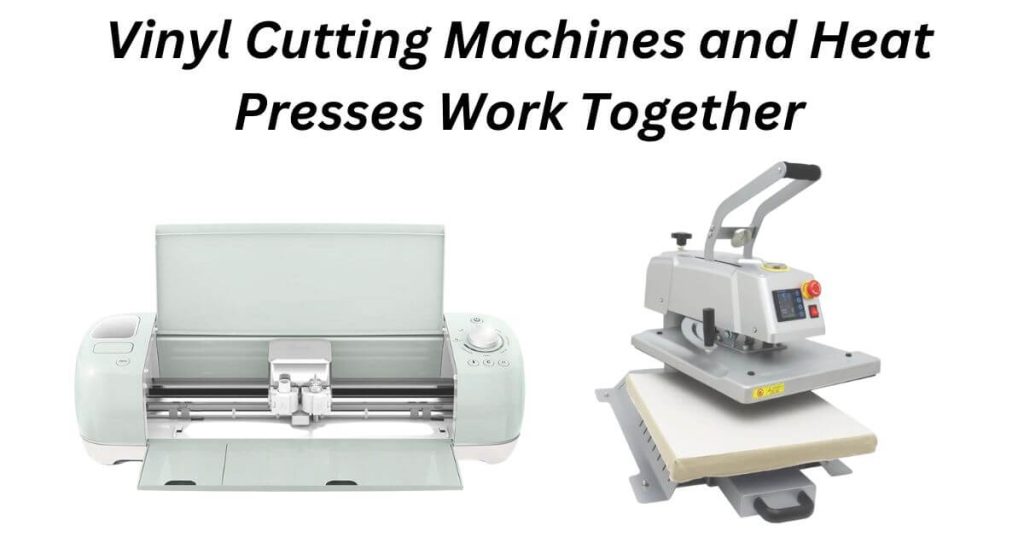
Understanding Vinyl Cutting Machines
Vinyl cutting machines are specialized devices designed to cut various materials with precision. They operate using a computer-controlled blade that follows digital designs created by incompatible software.
The machine’s functionality allows users to create intricate shapes, letters, and graphics by cutting through vinyl, cardstock, and fabric.
This technology is essential for producing custom decals, signs, and apparel designs, making it a valuable tool for hobbyists and professional screen printers.
Types of Materials They Can Cut
Vinyl-cutting machines are versatile and can handle a wide range of materials. Common materials include:
- Vinyl: Ideal for creating stickers, decals, and signage.
- Cardstock: Perfect for scrapbooking, card making, and paper crafts.
- Fabric: Used for appliqué designs and custom apparel.
- Heat Transfer Vinyl (HTV): Specifically designed for transferring designs onto clothing and textiles using a heat press.
- Specialty Materials: Some advanced machines can cut thicker materials like leather or even balsa wood.
By understanding the capabilities of vinyl-cutting machines, users can select the right machine for their specific crafting needs. This knowledge is crucial for maximizing creativity and efficiency in projects that require precision cutting.
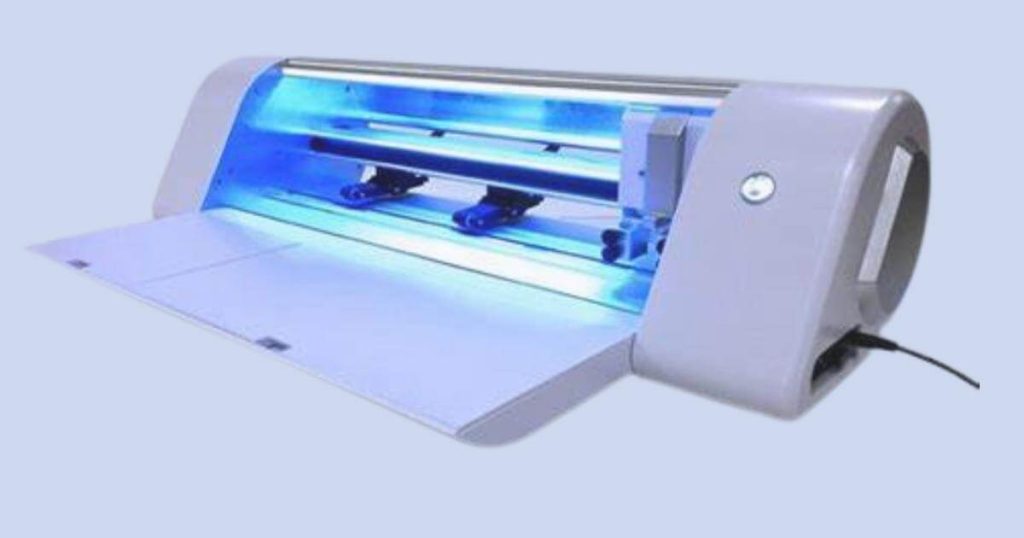
Understanding Heat Presses
Definition and Functionality
A heat press, also known as a heat transfer press, is a versatile machine that transfers designs, graphics, or images onto various substrates, including textiles and ceramics.
The primary function of a heat press is to apply heat and pressure evenly across the transfer material and the substrate.
This ensures proper adhesion of the design, resulting in vibrant and durable prints. Heat presses come with adjustable temperature controls, pressure settings, and timers to accommodate different materials and transfer methods.
Types of Heat Transfer Methods
There are several heat transfer methods that a heat press can utilize:
Heat Transfer Vinyl (HTV): This method involves cutting designs from vinyl sheets using a vinyl cutting machine. The HTV is then applied to fabric using a heat press, creating custom apparel and decals.
Sublimation Printing: Sublimation involves printing designs onto special sublimation paper with sublimation ink. When heated, the ink turns into gas and bonds with polyester fabrics or specially coated items, producing vibrant and long-lasting prints.
Inkjet Transfer Paper: This method uses inkjet printers to print designs onto transfer paper, which is then applied to the substrate with a heat press. It’s commonly used for transferring images onto dark or light fabrics.
Plastisol Transfers: Plastisol transfers involve printing designs onto special transfer paper with plastisol ink. These transfers can be applied to garments using a heat press, allowing for high-quality prints.
By understanding these different heat transfer methods, users can choose the most suitable technique for their crafting needs.
Each method offers unique benefits and applications, making it essential to select the right approach for your projects involving vinyl cutting machines and heat presses working together effectively.
The Workflow: From Design to Finished Product
Creating a finished product using vinyl cutting machines and heat presses work together involves a systematic workflow that starts with the design and culminates in the application. Here’s a step-by-step process to guide you through this workflow.
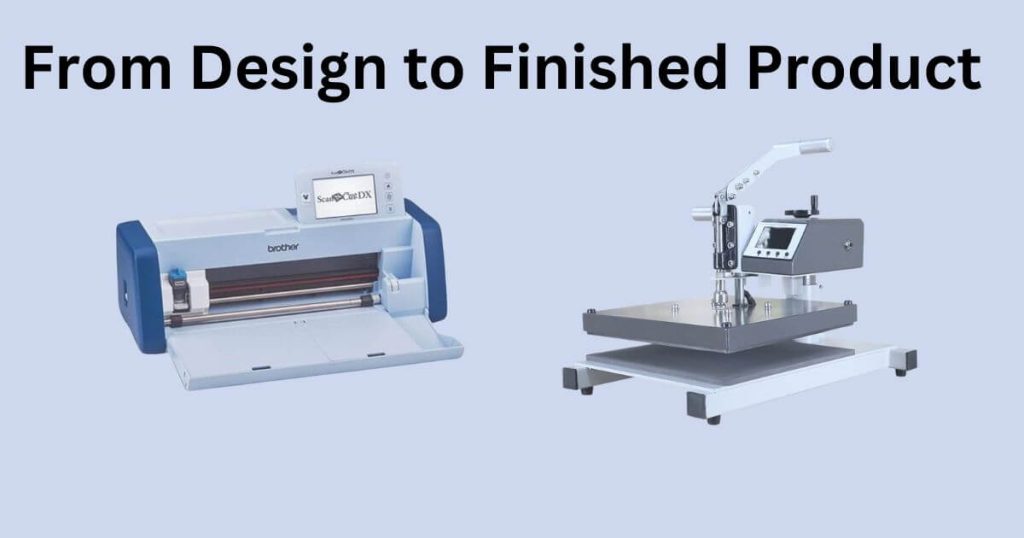
Step 1: Designing with Software
The first step in the workflow is to create your design using compatible software. Popular options include Adobe Illustrator, CorelDRAW, or specific vinyl-cutting software like SignMaster or FlexiSign.
When designing, ensure your artwork is in vector format, as this allows for precise cutting.
If you’re starting with a bitmap image, you may need to convert it into a vector file using tracing tools available in these programs.
- Tips for Designing:
- Ensure that all text is converted to outlines to avoid font issues during cutting.
- Keep the design simple; intricate details can complicate the cutting and weeding process.
- Remember to mirror your design if you are using heat transfer vinyl, as it needs to be applied face down on the fabric.
Step 2: Preparing the File for Cutting
Once your design is ready, save it in a format compatible with your vinyl cutter, such as .eps or .plt. Open the cutting software and import your design.
Adjust the settings according to the material you will be using. This includes selecting the appropriate blade depth, cutting speed, and force.
- Setting Up for Cutting:
- Check that the material width matches your design dimensions.
- Position your design within the cutting area of the software for accurate placement.
Step 3: Cutting the Design
With your file prepared, send it to the vinyl cutting machine. The cutter will follow the vector paths of your design, carefully slicing through the material.
After cutting, you’ll need to weed out the excess vinyl; this involves removing any unwanted pieces from around your design.
- Weeding Tips:
- Use a weeding tool to help lift small pieces without damaging your design.
- Take your time; rushing can lead to mistakes or damage.
Step 4: Applying Transfer Tape
Once you have weeded your design, apply transfer tape over it. This tape will help you lift and position your design accurately on the substrate (like fabric) before applying heat.
- Application Tips:
- Smooth out any bubbles in the transfer tape to ensure even adhesion.
- Make sure the surface of your substrate is clean and free from dust or grease.
Step 5: Using the Heat Press
Now, it’s time to use the heat press. Preheat it according to the specifications of the heat transfer material you are using.
Position your substrate on the heat press, then place your vinyl design (with transfer tape) on top. Close the press and apply heat and pressure for the recommended time.
- Heat Press Tips:
- Always check temperature and time settings based on material type.
- Use a protective sheet (like parchment paper) between the press and your project to prevent damage.
Step 6: Finalizing Your Product
After pressing, carefully peel away the transfer tape while it’s still warm or cold based on material instructions. Your custom design should now be securely adhered to your substrate.
By following these steps, you can effectively utilize both vinyl-cutting machines and heat presses to create high-quality custom products.
Understanding this workflow not only enhances creativity but also improves efficiency in producing professional-grade items for personal use or small business ventures.
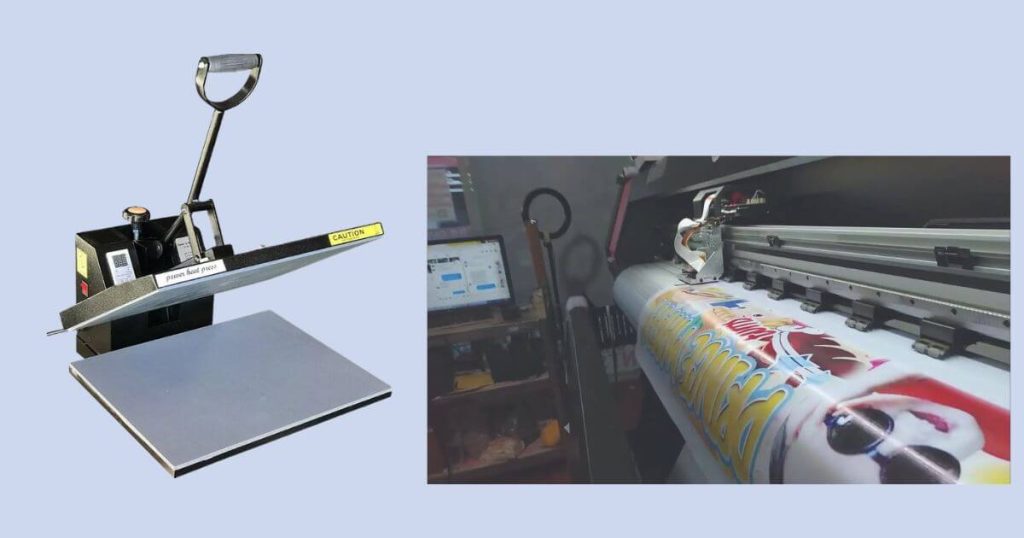
Benefits of Using Both Machines Together
Enhanced Creativity and Customization Options
Using vinyl cutting machines and heat presses together significantly enhances your creative possibilities. With a vinyl cutter, you can design intricate graphics, logos, and lettering that reflect your unique style or brand identity.
The ability to cut various materials, including heat transfer vinyl (HTV), allows for endless customization options in apparel and other projects.
When paired with a heat press, these designs can be transferred onto fabrics and other surfaces with precision. This combination empowers you to create personalized items such as custom t-shirts, tote bags, and home decor that stand out in the market or for personal use.
Read more about heat presses: 7 Best Heat Press Machine for Beginners | Reviews & Guides
Efficiency in Producing Professional-Quality Items
The synergy between vinyl cutting machines and heat presses streamlines the production process, making it more efficient. Once you’ve designed and cut your materials, the heat press allows for quick application of your designs to various substrates.
This efficiency is especially beneficial for small businesses or hobbyists who need to produce multiple items in a short amount of time. The professional-quality results achieved through this workflow can elevate your projects, making them suitable for sale or gifting.
Cost-Effectiveness for Small Businesses or Home Crafters
Investing in both a vinyl cutting machine and a heat press can be cost-effective for small businesses and home crafters.
By producing custom items in-house, you save on outsourcing costs associated with printing and embroidery services. Additionally, the ability to create a wide range of products—from apparel to home decor—means you can diversify your offerings without significant additional investment.
This versatility allows you to respond quickly to market trends or customer requests, ultimately increasing your profitability.
In summary, using vinyl cutting machines and heat presses together not only enhances creativity but also improves efficiency and cost-effectiveness.
This powerful combination equips crafters and small business owners with the tools needed to produce high-quality, customized products that meet their unique needs.
Tips for Effective Use
Best Practices for Operating Vinyl Cutters and Heat Presses
When using vinyl cutters and heat presses, following best practices ensures optimal results. Start by carefully reading the manufacturer’s instructions for both machines.
For vinyl cutters, load the material correctly with the backing side facing down to avoid cutting through it.
Adjust the blade depth and pressure according to the type of material you are using.
For heat presses, preheat the machine to the recommended temperature before placing your fabric inside.
Always use a protective sheet, such as parchment paper or a Teflon sheet, to prevent damage to your design during pressing.
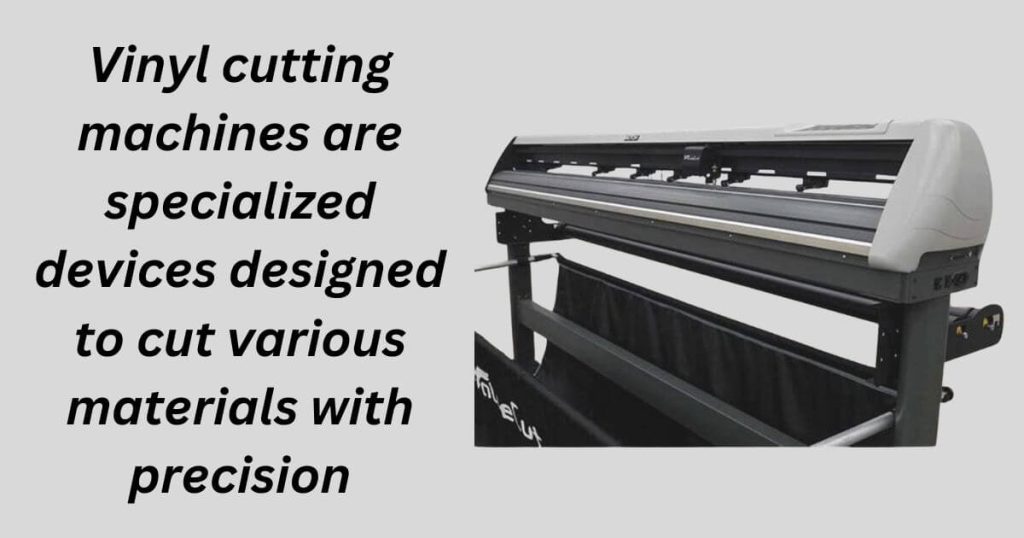
Regular Maintenance Tips for Longevity
Regular maintenance is crucial for extending the lifespan of your vinyl cutter and heat press. Clean the cutting blade and machine after each use to remove any debris or residue that may affect performance.
Check the blade for wear and replace it as needed; dull blades can lead to uneven cuts.
For heat presses, inspect the heating element and ensure that it maintains consistent temperatures.
Periodically check for cold spots using a laser temperature gun to ensure even heat distribution. Keeping both machines clean and well-maintained will help you achieve consistent results over time.
Experimenting with Settings for Optimal Results
Experimenting with different settings can lead to better outcomes when using vinyl cutters and heat presses.
Start by performing test cuts on scrap material to determine the ideal speed and pressure settings for your specific vinyl type. Adjust settings based on the thickness and texture of the material you’re working with.
Similarly, when using a heat press, try varying the temperature and pressing time based on the type of heat transfer vinyl (HTV) you are using.
Each HTV may have different requirements; for instance, some may need higher temperatures or longer pressing times than others. Document your findings to create a reference guide for future projects.
Common Projects Using Both Machines
Vinyl-cutting machines and heat presses work together seamlessly to create a variety of popular projects. Here are some examples that showcase their combined capabilities:
Custom Apparel
One of the most common projects is designing custom apparel, such as t-shirts, hoodies, and hats. Using a vinyl cutter, you can create intricate designs or logos from heat transfer vinyl (HTV).
Once cut, these designs can be easily transferred onto fabric using a heat press. This method allows for vibrant colors and detailed graphics, making it perfect for personal use or small business branding.
Home Decor
Vinyl-cutting machines can be used to create beautiful wall decals, stencils, and decorative signs. For example, you can cut out inspirational quotes or intricate patterns from adhesive vinyl.
After weeding the excess material, you can apply these designs to walls, furniture, or home accessories using a heat press or simply by applying pressure with your hands. This project adds a personal touch to your living space.
Car Decals
Creating custom car decals is another popular project. With a vinyl cutter, you can design unique graphics or messages that reflect your personality or brand.
Once cut, these decals can be applied to your vehicle’s windows or body using transfer tape and pressure. This project is not only fun but also allows for creative expression on the go.
Personalized Gifts
Vinyl cutting machines and heat presses are ideal for creating personalized gifts for special occasions. You can design custom mugs, tote bags, or pillow covers with names, dates, or meaningful quotes.
The vinyl cutter allows you to create intricate designs, while the heat press ensures they are applied securely and professionally.
Stencils for Crafts
Another creative use of these machines is making stencils for various crafting projects.
You can cut stencils from adhesive vinyl using a vinyl cutter and then use them with paint or other mediums to create beautiful artwork on canvas, wood, or fabric.
The heat press can help set the paint if needed.
Event Decorations
For events like weddings or birthday parties, you can use both machines to create customized decorations such as banners, table centerpieces, and party favors.
Cut intricate designs from vinyl and apply them to various surfaces with a heat press for a professional finish.
These projects highlight the versatility of using vinyl cutting machines and heat presses together.
The combination allows crafters to explore unique designs and produce high-quality items that cater to personal tastes or business needs.
Whether you’re creating custom apparel or decorative home items, this potent duo enhances creativity and efficiency in crafting endeavors.
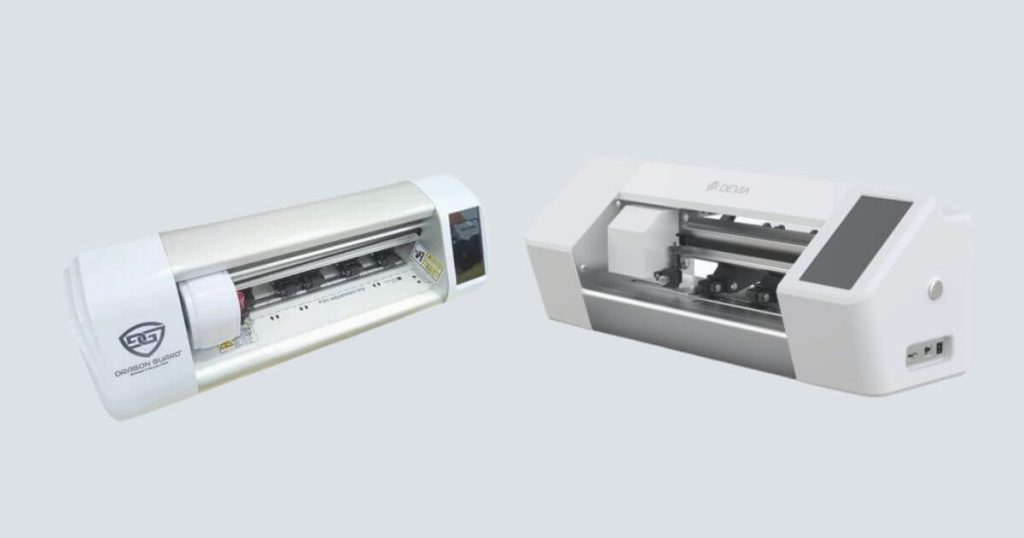
Resources for Learning and Inspiration
Online Communities, Tutorials, and Design Resources
Engaging with online communities can provide valuable insights and support for using vinyl cutting machines and heat presses. Platforms like Reddit, particularly the r/streetwear startup subreddit, offer discussions where users share their experiences and tips on using these tools effectively:
Additionally, websites like Echidna Sewing provide comprehensive how-to guides on heat transfer vinyl, detailing everything from cutting techniques to application methods.
For hands-on learning, Northeastern Makerspaces offers DIY training tutorials specifically focused on heat transfer vinyl projects, which can help you master the process step-by-step.
You can also explore design resources such as Creative Market or Design Bundles, where you can find premade graphics and fonts tailored for vinyl cutting. These resources can save time and inspire unique designs that you can apply using your heat press.
Recommended Software and Tools to Enhance Crafting Experience
To enhance your crafting experience with vinyl cutting machines and heat presses, consider the following software and tools:
Design Software: Programs like Adobe Illustrator or CorelDRAW are excellent for creating intricate designs in vector format. For beginners, Cricut Design Space or Silhouette Studio offer user-friendly interfaces specifically designed for vinyl cutting.
Cutting Software: Many vinyl cutters come with proprietary software that allows you to send designs directly to the machine. Ensure that your cutter’s software is compatible with the design software you choose.
Heat Press Models: Investing in a quality heat press is crucial for achieving professional results. Brands like Stahls offer reliable options that maintain consistent pressure and temperature, which is essential for successful transfers.
Weeding Tools: A good set of weeding tools will help you remove excess material from your designs after cutting. Look for precision tweezers and hook tools designed specifically for vinyl.
Protective Sheets: Always use parchment paper or Teflon sheets when applying heat to protect your designs and fabrics from direct contact with the heat press.
By utilizing these resources, vinyl-cutting machines and heat presses work you can enhance your skills and creativity when working with vinyl cutting machines and heat presses.
Engaging with communities, accessing tutorials, and using recommended software will empower you to create stunning, professional-quality projects that showcase your unique style.
FAQ
What is the primary function of a vinyl-cutting machine?
A vinyl cutting machine cuts designs from various materials, including vinyl, cardstock, and fabric.
How does a heat press work?
A heat press applies heat and pressure to transfer designs onto fabrics or other surfaces.
Can I use a regular iron instead of a heat press?
While a regular iron can work for small projects, a heat press provides more consistent temperature and pressure for professional results.
What materials can I cut with a vinyl cutter?
You can cut materials like heat transfer vinyl (HTV), adhesive vinyl, cardstock, and some fabrics with a vinyl cutter.
Why is it important to mirror designs before cutting HTV?
Mirroring ensures that the design appears correctly when applied to the fabric as you cut from the back side of the HTV.
What are some common projects that use both machines?
Common projects include custom apparel, home decor items, car decals, and personalized gifts.
How do I maintain my vinyl cutting machine and heat press?
Regularly clean both machines after use, check for wear on blades, and ensure the heat press maintains consistent temperatures.
Where can I find design inspiration for my projects?
Online communities, design resources like Creative Market, and tutorial websites offer plenty of inspiration and guidance for crafting projects.
Closure
In conclusion, the synergy between vinyl cutting machines and heat presses creates a powerful combination for crafters and small business owners alike.
By using a Vinyl-cutting machines and heat presses work intricate graphics, and then applying those designs with a heat press, you can achieve professional-quality results in your projects.
This collaboration not only enhances creativity but also streamlines the production process, allowing for efficient creation of custom apparel, home decor, and more.
We encourage you to explore the creative possibilities that come with utilizing both tools. Whether you’re a hobbyist looking to personalize gifts or a small business aiming to expand your product offerings, the potential for unique and customized items is limitless.
Embrace the journey of crafting with vinyl cutting machines and heat presses, and let your imagination guide you to new and exciting projects.

Leave a Reply
You must be logged in to post a comment.